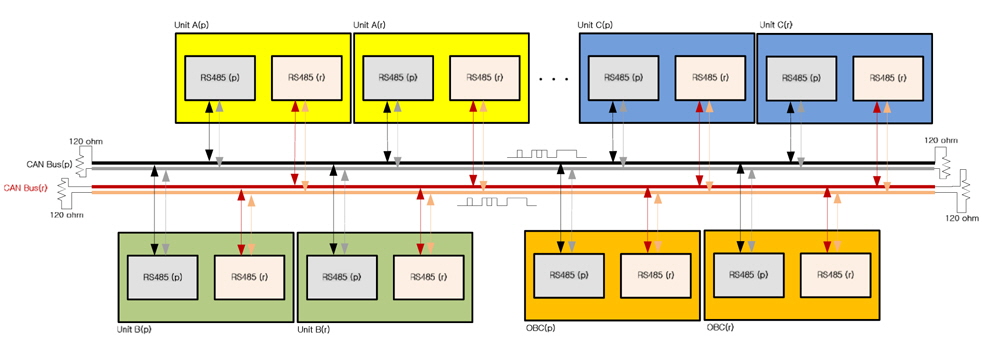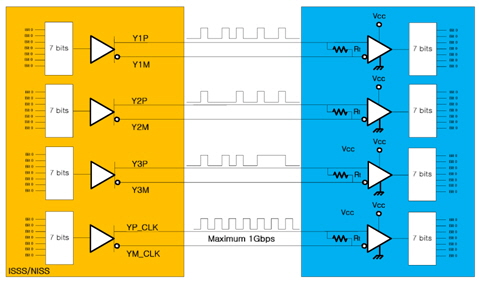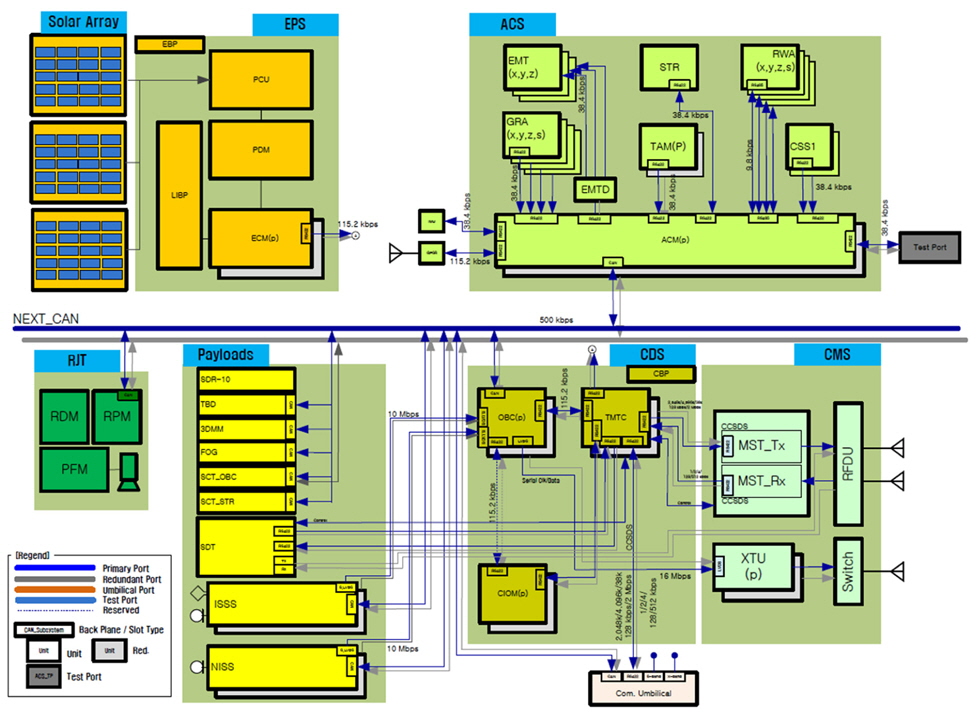



The communications link in a space program is a crucial point for upgrading its performance by handling data between spacecraft bus and payloads, because spacecraft’s missions are related to the data handling mechanism using communications ports such as a controlled area network bus (CAN Bus) and a universal asynchronous receiver and transmitter (UART). The NEXTSat-1 has a lot of communications ports for performing science and technology missions. However, the top level system requirements for the NEXTSat-1 are mass and volume limitations. Normally, the communications for units shall be conducted by using point to point link which require more mass and volume to interconnect. Thus, our approach for the novel communications link in the NEXTSat-1 program is to use CAN and serializer and deserializer low voltage differential signal (SerDesLVDS) to meet the system requirements of mass and volume. The CAN Bus and SerDesLVDS were confirmed by using already defined communications link for our missions in the NEXTSat-1 program and the analysis results were reported in this study in view of data flow and size analysis.
The NEXTSat-1 program has been under development to perform two science missions and seven core technology missions since 2012 in Korea Advanced Institute of Science and Technology (KAIST). The main mission objective of the instrument for the study of space storms (ISSS) is to detect plasmas and space radiations using the detectors and probes in South Pole (Shin 2013). ISSS consists of a medium energy particle detector (MEPD) with 100 keV, a high energy particle detector (HEPD) with 10 MeV for radiation detection, a Langmuir probe (LP), a retarding potential detector (RPA) and an ion drift meter (IDM) for space plasma detection. The other main mission objective of the near infrared (NIR) imaging spectrometer for star formation history (NISS) is the acquisition of astronomical imaging spectroscopic data in the wavelength range from 0.95 μm to 3.8 μm for the study of star formation history using a spectrometer with the field of view (FOV) greater than 1˚ by 1˚ to cover typical nearby galaxies. In addition to these science missions such as ISSS and NISS, the NEXTSat-1 program has seven space core technologies to be demonstrated in space after launch, although one of the core technologies is under review. In order to accomplish the NEXTSat-1’s mission in space, each bus as well as payloads shall be interconnected by communications link to handshake the status of health (SoH) and the mission data such as observations and technology demonstrations (Oh & Lim 2009). In order to make optimal performance in communications without any loss during data handling (Song & Lim 2006, and Lee & Lim 2011), we have already defined the communications baud rate and check the link performance for each unit and payload, because each unit has a required throughput (Sohn et al. 2012). Therefore, we have checked the communications link performance considering already defined baud rate, and reported the communications link for the NEXTSat-1 mission operation with CAN Bus, UART, and SerDesLVDS (TI Data Sheet 2002).
The NEXTSat-1 has a lot of communications ports to connect the units with differential signal lines which seem to have low noise characteristics. In order to implement the communications network in the NEXTSat-1, Fig. 1 shows the overall communications configuration of the NEXTSat-1 considering a spacecraft bus, science payloads, and space core technology payloads. Each communications port has a different baud rate which depends on the unit throughput. Therefore, we have checked its performance considering already defined communications baud rate, whether its performance shall meet the requirements or not.
3.1 Link Applications and Requirements for Subsystems
Before proceeding to next section, we will investigate all the unit ports in terms of baud rate, signal level, and required performances. The NEXTSat-1 consists of a command and data handling subsystem, an electrical power subsystem, an attitude control subsystem, a resistojet subsystem, and a communications subsystem in the spacecraft bus. And the science payloads consist of the ISSS and the NISS for science missions. In addition to the bus and the science payloads, the space core technologies are under design and development for space verifications. Space core technologies consist of the fiber optic gyro (FOG), the 3- dimensional mass memory (3DMM), the S-band digital transponder (SDT), the space data recorder-10 (SDR-10), the SCT_on-board computer (SCT_OBC), and the star tracker (STR).
The communication speeds required for unit interface are 38.4 kbps and 115.2 kbps except the S-band transmitter and receiver. However, the S-band transmitter and receiver requires the adjustable baud rates of 1 kbps, 2 kbps, 4 kbps, 32 kbps, and 512 kbps during uplink, and the downlink of S-band requires the baud rates of 2.048 kbps, 4.096 kbps, 32 kbps, 128 kbps, and 2,000 kbps. In addition, the S-band requires another baud rate for the control which shall make a baud rate setting packet via a serial communications line. Those baud rates were already defined for our missions and its communications speeds were already verified in space with previous programs.
[Table 1] Unit requirements of communications network of the NEXTSat-1.
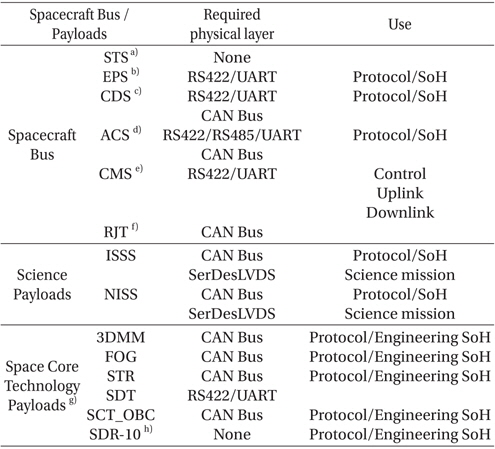
Unit requirements of communications network of the NEXTSat-1.
3.2 Size of SoH and Mission Data Being Generated
In case of the NEXTSat-1, communications link shall be routed via the subsystem controller such as OBC, ACM, and ECM as well as ISSS and NISS with CAN Bus including space core technologies. According to the preliminary system design, all the units will generate the SoH data during mission operations on orbit. With those data, we did the performance check to find out whether the current communications speed is applicable or not considering already defined communication baud rates. The following Table 2 shows the SoH data and the science data for the ISSS and the NISS.
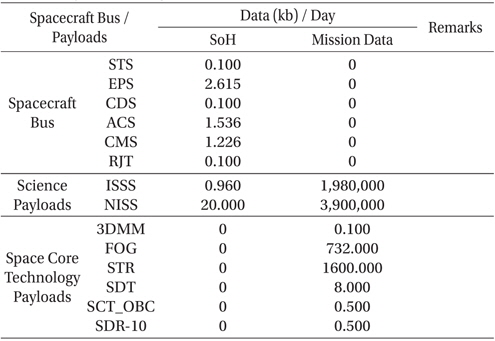
SoH and science data which were generated from spacecraft bus and payloads during mission operation.
According to Table 2, there are two types of data generation for all the units and the payloads. The SoH represent the status data of units in terms of current, voltage, temperature and so on during operations on orbit. All the SoHs of the NEXTSat-1 will be monitored by OBC on orbit and a ground station’s operator. Therefore, the SoHs are generated periodically from each unit, which are stored on OBC’s memory area. Those data will be downloaded on command by the ground station. Also, we have investigated the science mission data which are generated from the ISSS and the NISS depending on the scenario. The ISSS generates 1.98 Gb of observation data, and the NISS generates 3.90Gb of science data during the mission operations.
3.3 Link Design and Performance Check
3.3.1 Physical Layer
Based on the differential communications mechanism, a differential signal shall be applied for the NEXTSat-1 links to ensure a minimum signal noise during data handshaking. Among several communications links, we have chosen a differential signal using RS485 in physical layer as shown in Fig. 2. All the SoH data will be transmitted and received in full duplex mode using CAN Bus, which means there is no data loss during data processing. On the other hand, the science data generated from the ISSS and the NISS shall be processed in high speed, because science payloads data are generated much higher speed than other links for proper missions. Therefore, unlike normal SoH data processing, the SerDesLVDS link is used as the science payloads link, which has a data port and a clock port for ensuring data. Fig. 4 shows the SerDesLVDS interface between bus and payloads in physical layer.
3.3.2 Baud Rate Design and Throughput Check
In this section, we have checked communications links performance and performed the test to verify that the communication speed is fast enough to process the generated data during mission operations and to find out the necessity of additional baud rate to transmit the SoH data to OBC via CAN Bus or UARTs. The spacecraft bus generates the SoH data ranging from 0.1 Gb to 0.5 Gb. Those data shall be processed with an already defined baud rate.
3.3.3 X-band Downlink and Throughput Check
Science data for the ISSS and the NISS shall be stored in OBC and the size of stored data is maximum of 4 Gb. During the operation, the NEXTSat-1 circulates the orbit 14 times a day and the contact time to ground station will be within 10 or 15 minutes a day. Total stored data shall be downloaded to ground station during the contact period. Thus, we have designed the X-band transmitter with 16 Mbps baud rate considering power consumption and link margin from the space. Fig. 4 shows the link configuration from the payloads to OBC. In this configuration, the science data will be downloaded completely within 4 or 5 minutes.
Therefore, the science data shall be transmitted to OBC via the SerDesLVDS channels with 10,000 kbps baud rate and stored in the mass memory in OBC. Then, the stored data shall be linked to the X-band transmitter to be transmitted to the ground station without any loss.
The NEXTSat-1 has several communications links to process the SoH and the science mission data, RS422, RS485, SerDesLVDS, and CAN Bus as well as some umbilical links. Using those resources and the generated data, the processing time and performance were checked as shown in Table 3. Most of the links have a proper design margin which is a provision for preliminary and critical design phases. Therefore, we have figured out the link performance using already defined communications link in terms of those links, performance, margin and so on.
[Table 3.] Baud rate and performance check of the NEXTSat-1.
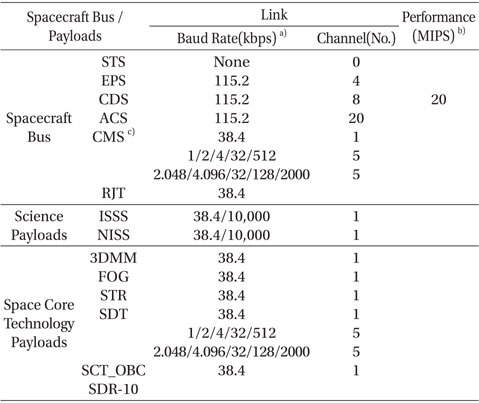
Baud rate and performance check of the NEXTSat-1.
According to the communications link for the NEXTSat-1, we have designed the independent controller such as an EPS control module (ECM), an ACS control module (ACM), and an on-board computer (OBC) as shown in Fig. 5 using CAN Bus. In order to meet the top level requirements, the CAN Bus was applied to support the maximum baud rate of 500 kbps. Normally, communications links were implemented by parallel to parallel interface using drivers. However, a lot of wires are required to implement the interface. Therefore, a special component such as CAN Bus was designed to be applied to the NEXTSat-1 program to enable the system simplification and some mass reduction (Shin et al. 2011). According to the analysis results of communications link, the science payloads shall be interconnected via CAN Bus which supports up to 500 kbps baud rate to handle the SoH data generated from the science payloads successfully. Since payloads for the space core technologies produce a small amount of engineering data compared with the science payloads, the SerDesLVDS link is not necessary. Therefore, the space core technologies will have CAN Bus interface only with the maximum baud rate of 500 kbps which provides a proper communications link margin.
In this work, we have performed the communications link analysis considering a lot of link interfaces between spacecraft bus and payloads by using already defined communications links. The NEXTSat-1 has design limitations on power as well as mass and volume. Thus, from the beginning of the program, we should consider the top level requirements such as power generation which depends on the spacecraft size because the power is generated from the solar array panel attached to the outside of the spacecraft. To meet those design limitations in the NEXTSat-1 program, we have studied the system clock which has an influence on the system power consumption. According to the previous results of communications link which was already allocated for each unit considering performance, the baud rate of 115.2 kbps is suitable for the data handling and processing between units via UARTs and the CAN Bus supports adjustable baud rates up to 500 kbps. Thus, the spacecraft bus such as ACM, ECM and OBC is interconnected with the link speed of 115.2 kbps. In case of the science payloads, those subsystems shall be linked by SerDesLVDS which is a special link format with data, clock and valid signals. Each science payload requires the baud rate of 10,000 kbps, because the ISSS and the NISS generate the science data by 10,000 kbps during the missions. In this analysis, current communications links have been verified to be fast enough to process those science data without data loss. Therefore, the link speeds of the buses are 115.2 kbps, 500 kbps, and 10,000 kbps for the spacecraft bus, CAN Bus, and SerDesLVDS, respectively. Based on the top level requirements of the system and the payload, we have checked the communications link for the required missions and reported the optimal configuration of communications link for the NEXTSat-1.



